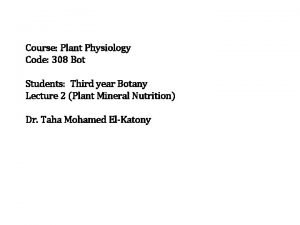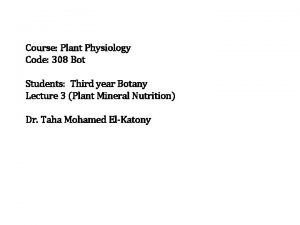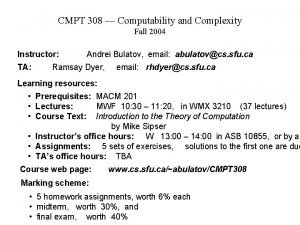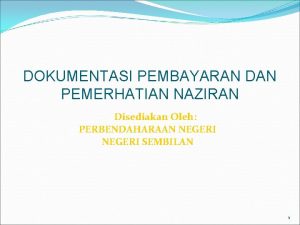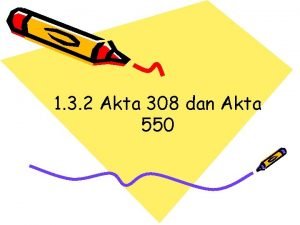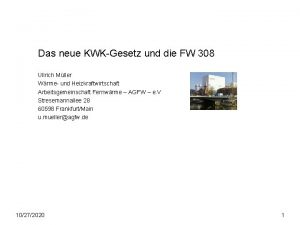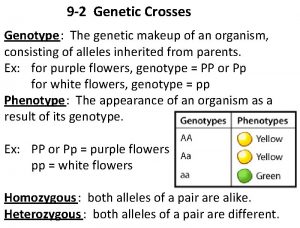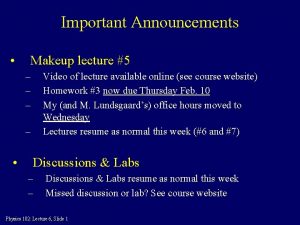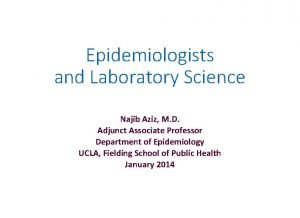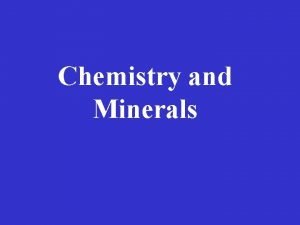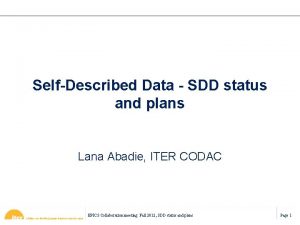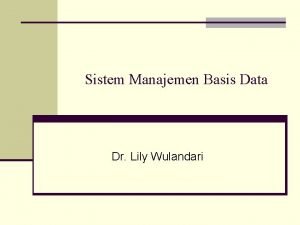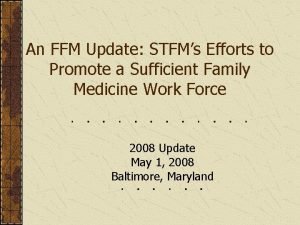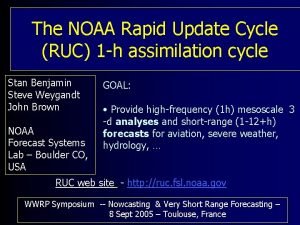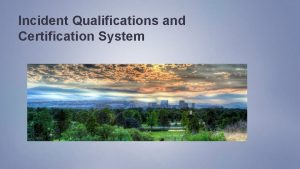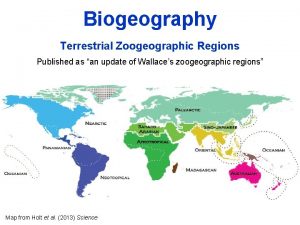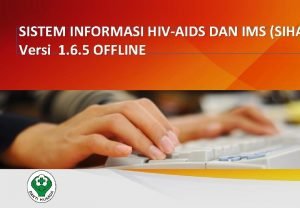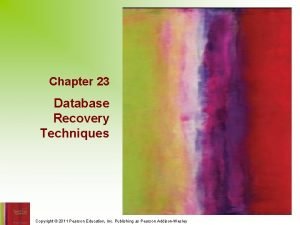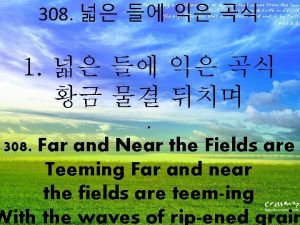Update Makeup Khoury 308 12 30 2 00








































































































- Slides: 104

Update • Make-up – Khoury 308: 12. 30 – 2. 00. pm Thursdays – FHS 106: 3. 30 – 5. 00 pm Thursdays • The next quiz (chapters 3 and 4 plus slides) – Wednesday 9/10/2020 1

YOUR QUESTIONS 2

Climate Change: 1. Climate change issue and its effects on different kinds of species 2. If this climate change continues – how do you predict Lebanon’s climate will become? 3. Why are humans the only victims of global warming and not the other organisms? 4. Why does global warming have the big effect on earth? 5. Why is everything that is happening the blame of climate change? 6. Why can’t I see the change that is happening in the environment? 7. Why is global warming increasing? 8. To understand the how and why of climate change from country to another? 9. Can we fix climate change? 10. (What is the composition of the atmosphere around us? ) 11. (How can we treat ozone depletion? ) Lebanon 1. 2. 3. 4. 5. 6. What does ecology suggest [should be] done so that the act of arson (deliberately starting forest fires for the sake of wood) by stopped? Lebanon has always been known of its olives and especially quality of abundance. Why, in these couple of years, has this resource significantly declined, especially in Mount Lebanon area? Why is there no animal diversity in Lebanon? Why aren’t Lebanese politicians benefiting from the natural resources? Why doesn’t Lebanon use its natural resources to provide electricity and sources of energy? Biofuels in the Middle East – would it work? Human Health 1. 2. 3. How is the environment related to human diseases? How are those diseases transmitted to us? Why is ecology essential for pre-med students? Are we adapted to pollution? Energy 1. 2. Methane gas produced by cows. Can it be a solution to our fuel resources? Could we really survive without oil? Pollution 1. How is pollution related to the damage of our ecosystem and will it be really [? ] toward the end of the world very soon? 2. What are the consequences of the oil spill in the Gulf of Mexico and what are its impacts on the marine species? 3. We may be able to decrease pollution but would we be able to eliminate it? 4. The inappropriate use of pesticides which is decreasing the bee population around the world and its effects on our environment 5. Pesticide effects on marine life 6. How can soil be treated? 7. Does the leather industry threaten certain population with extinction? Animals/Communities 1. What are the side effects for the decrease in the number of species in a certain community? 2. How could we know the effect of some animals on our life cycle? 3. What is the effect of experimental mutation that may release a new kind of species? 4. Learn about extinct species – and how to save them 5. Evolution of the newest species 6. In some countries, they are genetically manipulating trees to grow in their countries. What effect might that have? 7. What are the benefits of mosquitoes? Policy… 1. Are humans the biggest threat to our ecological system? 2. How could we have a more beautiful, safe, healthy environment? 3. How can reserves improve our environment and the preservation of species in different communities? 4. Why are some countries given the liberty to massacre birds for the sake of crops, ex Turkey? Miscellaneous 1. What happened to dinosaurs? 2. How was the beginning of the Earth? 3. What about volcanoes? 4. How can we know about earthquakes? 5. Why is eating pork prohibited in Islam? 6. Why don’t we eat bugs since they contain high amounts of protein? 7. Green buildings 8. What is the dumbest animal? The chicken 3

Your climate change questions – can you answer (some of) them? 1. 2. 3. 4. 5. Already discussed the science of climate change (remember? ) 6. 7. 8. 9. 10. Why is global warming increasing? Climate change issue and its effects on different kinds of species Why does global warming have the big effect on earth? If this climate change continues – how do you predict Lebanon’s climate will become? Why are humans the only victims of global warming and not the other organisms? Why is everything that is happening the blame of climate change? Why can’t I see the change that is happening in the environment? To understand the how and why of climate change from country to another? 11. Can we fix climate change? How is the environment related to human diseases? How are those diseases transmitted to us? Why is ecology essential for pre-med students? 12. 13. (What is the composition of the atmosphere around us? ) (How can we treat ozone depletion? ) 4

Terrestrial Ecosystem Response to Climate Change

Global Change and Effects on Terrestrial Ecosystem Introduction n Temperature, precipitation, latitude and altitude all determine distribution of major terrestrial ecosystems (biomes). n Plants found within the different biomes are influenced by soil type, water shed conditions and amount of sun. n Specific combinations of temperatures and precipitation ensure the survival and thriving of plants within a given environment (known as Climate space).

Terrestrial Ecosystems are an… • • • Integral part of global carbon system Plants take in and store carbon dioxide from the atmosphere through photosynthesis Below ground microbes decompose organic matter and release organic carbon back into the atmosphere www. bom. gov. au/info/climate/change/galler y/9. shtml Cycle shows how nature’s sources of CO 2 are self regulating – that which is released will be used again – Anthropogenic carbon not part of natures cycle – is in excess

n n n Major Biomes and Their Vegetation Tundra – no trees, lichens, grasses and shrubs Taiga (or Boreal Forest) – coniferous evergreens Temperate forests – include evergreens (spruce), deciduous forests (oaks), mixed forests, and temperate rain forests (sequoias) Tropical rain forests – greatest amount of diversity in vegetation (vines, orchids, palms) Grasslands – grasses, prairie clover Deserts – cacti, small bushes

Major Terrestrial Biomes • • Geographic distribution of biomes are dependent on temperature, precipitation, altitude and latitude Weather patterns dictate the type of plants that will dominate an ecosystem faculty. southwest. tn. edu/. . . /ES%20%20 we 16. jpg

Million years before present 570 505 438 408 360 286 245 208 144 66 2 10 K

tundra Global Distribution of Vegetation 18, 000 years ago desert conifers grassland woodland Prentice, C. I. , Guiot, J. , Huntley, B. , Jolly D. and Cheddadi, R. , 1996, Reconstructing biomes from palaeoecological data: a general method and its application to European pollen data at 0 and 6 ka. Climate Dynamics 12: 185 -194. taiga

Global Distribution of Vegetation 6, 000 years ago temperate deciduous cold deciduous taiga tundra conifers grassland desert woods & scrub Prentice, C. I. , Guiot, J. , Huntley, B. , Jolly D. and Cheddadi, R. , 1996, Reconstructing biomes from palaeoecological data: a general method and its application to European pollen data at 0 and 6 ka. Climate Dynamics 12: 185 -194.

Global Distribution of Vegetation - Present tundra taiga temperate deciduous warm mix grassland tropical R. F. Prentice, C. I. , Guiot, J. , Huntley, B. , Jolly D. and Cheddadi, R. , 1996, Reconstructing biomes from palaeoecological data: a general method and its application to European pollen data at 0 and 6 ka. Climate Dynamics 12: 185 -194. cold deciduous

Shifts in Terrestrial Habitat • 18, 000 years ago Spruce trees and oak trees filled small pockets of habitat – as climates warmed Spruce trees migrated into the Northern Hemispheres and the Oak trees expanded in to Southeastern U. S. , Western Europe and Southern Europe • Shifts in vegetation occur slowly tree species were able to successfully expand into favorable regions 18 Kya 18 kya ice sheet oak spruce 9 Kya 9 kya ice spruce oak Present spruce ice spruce oak Distribution of spruce and oak forests in Northern Hemisphere since the glacial period 18, 000 kya

tundra PRESENT taiga DAY BIOMES desert temp. decd. forest desert grassland trop. rain forest scrub forest temp rain forest desert

Tundra Greenland Alaska Canada Ice land Location: Regions south of the ice caps of the Arctic and extending across North America, Europe and Siberia (high mountain tops) N. Europe Siberia Yakutsk Average Temperature: -40°C to 18°C Average Precipitation: 150 to 250 mm of rain per year Type of vegetation: Almost no trees due to short growing season and permafrost; lichens, mosses, grasses, and shrubs

Average annual temperature and precipitation Yakutsk, Russia Location: 62. 1 N; 129 W earthobservatory. nasa. gov

Boreal Forest (Taiga) Canada S. W. U. S Europe Asia Temperature: -40°C to 20°C, average summer temperature is 10°C Precipitation: 300 to 900 millimeters of rain per year Vegetation: Coniferous-evergreen trees Location: Canada, Europe, Asia, and the United States Other: Coniferous forest regions have cold, long, snowy winters, and warm, humid summers; well-defined seasons, at least four to six frostfree months

Boreal Forest (Taiga) Average annual temperature and precipitation Beaverlodge, Alberta, Canada 55 o. N; 119 o W earthobservatory. nasa. gov

Temperate Forests Four types: 1. deciduous forests 2. evergreen forests 3. mixed deciduous and evergreen 4. temperate rain forests Location: Eastern United States, Canada, Europe, China, and Japan Average Yearly Temperature: Between -30°C to 30°C; hot summers, cold winters; sunlight varies between seasons Average Yearly Precipitation: 750 to 1, 500 mm of rain per year www. windows. ucar. edu/tour/link=/earth/forest_e co. html Vegetation: Deciduous - Broadleaf trees (oaks, maples, beeches), shrubs, perennial herbs, and mosses. Evergreen – (N. America) – Spruce, Hemlock, Pine and Fir trees Temperate Rainforests – (CA, OR, & WA) – made up of Red wood and Sequoias

Average annual temperature and rainfall Staunton, Virginia, United States 38 o. N; 79 o. W earthobservatory. nasa. gov

Tropical Forests General Characteristics: Average Temperature: 20°C to 25°C, must remain warm and frost-free Average Precipitation: 2, 000 to 10, 000 millimeters of rain per year Average Humidity: Between 77 – 88% Types of Vegetation: Large trees reaching up to 240 feet, have the most diverse trees than any other biome: vines, orchids, ferns Tropical rainforests: • Cover less than 6% of Earth’s land surface • Produce more than 40% of Earth’s oxygen • Contain more than half of all the worlds plants and animals • ¼ of all medicines come from rainforest plants • Scientists believe more than 1400 tropical plants thought to be potential cures to cancer

Tropical Rainforest Amazon river basin Zaire India S. E. Asia New Guinea Madagascar Queensland 3 major geographical areas: 1. America: Amazon river basin 2. Africa: Zaire basin, small area of W. Africa, Eastern portion of Madagascar 3. Asia: West coast of India, Assam, S. E. Asia, New Guinea and Queensland, Australia "Rainforests", http: //passporttoknowledge. com/rainforest/GEOsystem/Maps/se_asia. html, (3/18/02)

Tropical Forest Campa Pita, Belize 15 N latitude earthobservatory. nasa. gov Average annual temperature and precipitation

Southeast Asia Tropical Rainforest Monsoons role n n SE Asia has a tropical wet climate which is influenced by ocean wind systems originating in the Indian Ocean and China Sea 2 monsoon seasons: q q n Northeast monsoons (Oct. – Feb) – bring heavy rains to Eastern side of the islands Southwest monsoons (April – Aug) – more powerful of the two seasons – brings heavy rainfall to the western side of the islands – Eastern side of islands dry – but windy (due to rain shadow) Change in monsoon cycle bring heavy consequences q q Ex. 1992 – 1993 – logging degraded primary foresting making it vulnerable to fires. A drought brought on by El Nino created devastating fires destroying 27, 000 km 2 of acreage. In 1998 the same type of thing happened again when El Nino created a weak monsoon season – destroying many plant and animal species.

Grasslands Location: The prairies of the Great Plains of North America, the pampas of South America, the veldt of South Africa, the steppes of Central Eurasia, and surrounding the deserts in Australia Temperature: Dependent on latitude, yearly range can be between -20°C to 30°C Precipitation: About 500 to 900 mm of rain per year Vegetation: Grasses (prairie clover, salvia, oats, wheat, barley, coneflowers) Other: Found on every continent except Antarctica

Average annual temperature and rainfall Ingeniera White, Argentina 40 o. S; 6 o. W earthobservatory. nasa. gov

Deserts Location: Found north and south of the Equator Temperature: Average of 38°C (day), average of -3. 9°C (night) Precipitation: About 250 mm of rain per yr Vegetation: Cacti, small bushes, short grasses Other: Perennials survive for several years by becoming dormant and flourishing when water is available. Annuals are referred to as ephemerals because some can complete an entire life cycle in weeks.

Average yearly temperature and rainfall El-Oasr el-Akhdar, Egypt 26 o. S; 30 o. E earthobservatory. nasa. gov

So … what are the predictions? ? ? woodland n n Arid deserts in Southwestern U. S. will shrink as precipitation increases Savanna/shrub/woodland systems will replace grasslands in the Great Plains Eastern U. S. – forests will expand northerly – weather conditions will become more severe Southeastern U. S. – increasing droughts will bring more fires – triggering a rapid change from broadleaf forests to Savannas Climate change p. 104 shrub land grassland forest arid Present day grassland forest grassland shrub land grassland woodland Predicted Distribution

Predicted Change in Biomes Loss of existing habitat that could occur under doubling of CO 2 concentration. Shades of red indicate percentage of vegetation models that predicted a change in biome type.

Predictions of Sugar Maple in Eastern North America predicted new growth Distribution of Sugar Maple in Eastern North America will change due to an increase in temperature and a decrease in moisture shifting further north east. predicted new growth overlap present range Prediction based on increased temperature and decrease precipitation

More Predictions q Douglas Fir found in wet coastal mountains of CA and OR will shrink in low lands and be replaced by Western pine species which are more drought tolerant. q Overall Western U. S. climate is predicted to shift to favor more drought tolerant species of pine Western Hemlock and Douglas fir found on Western slope Wet western slope will shrink and be replaced by pine and oak Eastern slope will become drier and shift to Juniper and Sagebrush

Frequency of forest fires will increase, reducing total American boreal forest area.

Shifts in Terrestrial Habitat • It is predicted that at the end of this century there will be large scale shifts in the global distribution of vegetation in response to anthropogenic climate change. • With man doubling the amount of carbon dioxide entering into the atmosphere the climate is changing more rapidly then plant migration can keep up. www. usgcrp. gov/usgcrp/seminars/960610 SM. html Potential distribution of the major world biomes under current climate conditions Projected distribution of the major world biomes by simulating the effects of 2 x. CO 2 -equivalent concentrations

Boreal and Alpine Vegetation • Research indicates the greatest amount of change will occur at the higher latitudes • Northern Canada and Alaska are already experiencing rapid warming and reduction of ice cover • Vegetation existing in these areas will be replaced with temperate forest species • Tundra, Taiga and Temperate forests will migrate pole ward • Some plants will face extinction because habitat will become too small (ex. Mountain tops of European Alps) Predicted changes in Siberian vegetation in response to doubling of CO 2 Climate change

Grasslands and Shrub Lands n Grassland will change to deserts or shrub lands q q q n Exposing greater amounts of soil Increasing soil temperature – poor nitrogen content – poor plant growth Barren soil exposed to winds and transported into atmosphere as dust and trapping IR – leading to more warming Models of: n n n Climate change Plant growth Soil – water Predict shifts in distribution of major North American prairie grasses over a 40 year period

Impacts on Lebanon? n recent studies found that the Arab region experienced an uneven increase in surface air temperature ranging from 0. 2 to 2. 0ºC that occurred from 1970 to 2004

Impact high… n n Semi-arid and arid regions are highly vulnerable to climate change If temperature gets higher If precipitation gets lower pressure on natural and physical systems would be intensified climate change impact 39

The Arab region will… n n n n Face an increase of 2 to 5. 5 C in surface temperature by 2100 Face a decrease in precipitation from 0 to 20% shorter winters dryer and hotter summers higher rate of heat waves higher level of weather variability more frequent occurrence of extreme weather events climate change impact 40

Impact on freshwater sources 41 climate change impact

Status of freshwater here n n Reminder: most of the Arab countries are located in arid and semi-arid regions; low and limited water resources + high evaporation Total water resources = total renewable ground water + internal surface water resources + external surface water resources climate change impact 42

First order impacts… n Mediterranean hydrological systems q q n Wetter winters Dryer and hotter summers Increase in evaporation from water bodies… Increase Evapotranspiration from crops Egypt q Increase the potential irrigation demand by 6 to 16% by 2100 climate change impact 43

Drought 44 climate change impact

Drought frequency n Increased during the last 20 to 40 years in Morocco, Tunisia, Algeria and Syria q q n Of the 22 drought years in the 20 th century, 10 occurred in the last 20 years, and three were successive (1999, 2000, 2001) in Morocco Recent droughts in Jordan and Syria worst ever recorded Varying conditions of water shortage in Lebanon in the last 10 years climate change impact 45

BUT NOT JUST DROUGHTS 46 climate change impact

Yemen: recent floods (October 2008) Dubbed the 'Manhatten of the desert', Shibam's 2, 000 -year-old mud-brick buildings are in danger of collapsing after recent floods 47 climate change impact

Observed Changes in Physical and Ecological Systems (from IPCC 2001) hydrology / sea ice animals plants study covers study based on glaciers large area remote sensing 9/10/2020 48

Those at Risk n Northern countries (Russia, Sweden, Finland) ½ of existing terrestrial habitats at risk n In Mexico, it’s predicted that 2. 4% of species will lose 90% of their range and threatened with extinction by the year 2055 n Population at greatest risk are the rare and isolated species with fragmented habitats or those surrounded by water, agriculture or human development n Polar bears facing extinction by prolonged ice melts in feeding areas along with decline in seal population

q 35% of worlds existing terrestrial habitat predicted to be altered q Studies found that deforestation in different areas of the globe affects rainfall patterns over a considerable region § Deforestation in the Amazon region of South America (Amazonian) influences rainfall from Mexico to Texas and in the Gulf of Mexico § Deforesting lands in Central Africa affects precipitation in the upper and lower U. S. Midwest www. sciencedaily. com/releases/2005/09/050918132252. htm

Key Conclusions from IPCC Recent Regional Climate Changes, particularly Temperature Increases, have Already Affected Many Physical and Biological Systems (high confidence, or >67% sure) Biotic change: 44 regional studies, 400 plants and animals, 20 to 50 years Physical change: 16 regional studies, 100 processes, 20 -150 yrs q q q q 9/10/2020 non-polar glacier retreat reduction in Arctic sea ice extent and thickness in summer earlier plant flowering and longer growing season in Europe poleward and upward (elevation) migration of plants, insects and animals earlier bird arrival and egg laying increased incidence of coral bleaching increased economic losses due to extreme weather events 51

Phenology Phenology: the study of a plant or animal’s progression through its life cycle in relation to the seasons Another main indicator of climatic fingerprint In Britain, for example, flowering and leafing occur 6 to 8 days earlier for every degree C rise in temperature 9/10/2020 52

Phenological Changes n Life-cycles of plants and animals have been affected by global change n Temperatures affecting plants growing season, flowering time and timing of pollination by insects have all been altered n Studies already showing q Mediterranean deciduous plants now leaf 16 days earlier and fall 13 days later than 50 years ago q Plants in temperate zones flowering time occurring earlier in the season q Growing season increased in Eurasia 18 days and 12 days in N. America over past two decades

Phenological Changes Penuelas J and Filella I 2001. Response to a warming world. Science 294: 793 – 795

Important to know the particular species’ requirements Migratory black-tailed godwit Shore bird Winters between Britain and Iberia Breeding in summer in Iceland Breeding pairs – high partner fidelity Male and females winter in different locations – but arrive in Iceland typically within 3 days of each other ? : how this degree of synchrony is maintained when the environmental conditions at the different sexes’ wintering sites are dissimilar? Pied flycatcher Migration is timed to availability of food for its nestlings However – in parts of the Netherlands the caterpillars is now at its food peak early in the season. There – the flycatcher population is in decline Will it be able to adapt in time? 9/10/2020 55

Biological communities and species shift Some species do not migrate – but will shift their geographical position or range in response to CC Climate is but one factor of many that determine a species’ spatial distribution – species rarely move uniformly with each other in response to climate change Plus Different species migrate at different rates Thus: takes time for ecological communities to stabilize after a period of CC Species at the leading edge of shifts/migrations tend to migrate faster than those already established Changes are asymmetrical: species invading faster from lower elevations or latitudes than resident species receding upslope or poleward Result: increase in species richness of communities at leading edge of migration Transitory biodiversity Plus: many of today’s systems are either managed or bound by land managed by humans == effective barrier to species migration Problem: old ecological communities disrupted + impeding species migration halted 9/10/2020 56

Arctic lakes n n n 1997 - 2004: decline of 1170 large lakes (> 40 ha); 11% Total regional lake surface area decreased by 6% (93 000 ha); 125 lakes vanished; Northerly lakes increasing in size – by 12% (13 3000 ha) q q q Increased precipitation in the north Southerly declines in lake area have outpaced northerly gains in lakes The more southerly permafrost soils no longer permanently frozen allow lakes to rain 9/10/2020 57

Mountain snow and ice Note: mountain snowpacks affect quantity and timing of water in streams supplying ecosystems in surrounding lowlands Nearly all mountains of sufficient height on Earth have snow caps Those will be reduced in volume – especially at lower latitudes Smaller mountain snow caps may be seasonally thicker due to extra precipitation Already happening – at lower and mid latitudes (China, N. A. and Europe) Plus: snow-cap melt run off will shift away from summer and fall when biological (and human) demand for water is greatest compared to winter and early spring Annual cycle of water supply for many terrestrial and human systems will see reduced temporal buffering 1/6 th of the human population relies on glaciers and seasonal snowpacks for water supply Over 50% of river flow dominated by snow melt in: all of Canada, NW states of US, all of Scandinavia (exc Denmark) Balkan Europe, Russia, NE China, much of Chile, SW Argentina and S of New Zealand 9/10/2020 58

Water and ice n n In terms of human # - most critical region: China and parts of India Supports 2 billion people Largest volume of ice outside of polar and peri-polar regions Nearly 70% of the Ganges’ summer flow and 50 -60% of other of the regions’ major rivers: melt water 9/10/2020 59

Tops of mountains… n Global warming thermally determined zonation on mountains changes and rises q n Cannot migrate above mountain summits Alpine biome is 3% of the vegetated terrestrial surface – and shrinking q Ural Mountains n n Mountain pygmy possum (S-E Australia) q q 9/10/2020 Temperatures risen by more than 4 C in 20 th century Tree lines have risen between 20 and 80 m upslope Reducing regional alpine lines by 10 – 20% Habitat favored by skiers Under serious threat 60

Highland forests of Monteverde, Costa Rica 20 species of 50 anurans (frogs and toads) in a 30 km 2 study area went extinct – Changes behavior of animals 9/10/2020 including endemic golden toad (1987) Population crashes all associated with decline in dry-season mist frequency – due raising of cloud-bank base (presumed) Harlequin frogs gathered near waterfalls increased change of attack by parasitic flies increased mortality 61

‘A message from the frogs’ – Blaustein and Dobston (Nature 2006 ) The harlequin frogs of tropical America are at the sharp end of climate change. About two-thirds of their species have died out, and altered patterns of infection because of changes in temperature seem to be the cause. Climate change has already altered transmission of a pathogen that affects amphibians – leading to widespread populations and extinctions 67 % of the 110 species of harlequin frogs endemic to the region have died in past 20 years 78 -83% of extinctions occurred in unusually warm years in the tropics Shifting temperatures are the ultimate trigger for the expansion of a pathogenic fungus 9/10/2020 62

‘A message from the frogs’ – Blaustein and Dobston (Nature 2006 ) “The powerful synergy between pathogen transmission and climate change should give us cause for concern about human health in a warmer world. ” 9/10/2020 63

Climate Change and Human Health 64

Epidemiological Framework Social Environment Host Agent Ecosystems Global 65

Climate change and health: pathway from driving forces, through exposures to potential health impact. Source: Climate Change and Human Health – Risks and Reponses. Summary (WHO, 2003)

Climate Change and Human Health Pathways

POOR RAINS Inadequate in volume and distribution Poor grass Poor Harvest People Underfed (Malnutrition) Poverty Animal death Less meat, less milk Overgrazing where grass is good Animals underfed Over-grazing, trees cut down for fuel Grass /vegetation cover lost LAND DEGRADATION 68

Model projections n n Projected impacts of heat waves Average summer mortality rates attributed to hot weather episodes Changes with doubling or tripling of carbon dioxide -> projections of mortality can double or triple in next several decades 69

What have we seen? Recent Heat Waves Location Year Approx. No. Deaths India: June 2003 Western Europe 2006 3, 392* T: 122 degrees F > Europe 2003 72, 000# 1400 deaths India 1998 2, 541^ July Floods USA 1995 670 Japanese B USA 1993 200 encephalitis USA 1966 500 Aust [Melbourne] 1959 145^ ------------------------------------------------------------------------------ * Netherlands 1, 000; Belgium 940. # Italy 20, 089; France 19, 490; Spain 15, 090; Germany 9, 355. ^ Estimation. Total probably higher.

Summer 2003 heat wave n France, Germany, Italy, Spain, & Portugal q n Up to 72, 000 deaths Temperature was 10 degrees C (18 degrees F) above 30 year average 71

European Heatwave 2003

Hotter? n n n Expect more extreme weather events But not all extreme weather events are attributable to CC Need to know: what is expected with natural variability assuming no carbon dioxide forcing and with climate forcing from additional anthropogenic greenhouse gases UK Had. CM 3 model: an exceptionally warm summer up to 2020 will become a normal summer by the 2040 s in Europe … they projected an increase 100 -fold over the next four decades 9/10/2020 73

So…Effects of Climate Change n DIRECT: Thermal stresses: extremes q n Respiratory consequences: q n of hot or cold changes in patterns of exposure to spores, moulds, etc. Direct effects: q loss of life or health due to: storms, floods, drought

Air pollution and climate change Pollen and Groundlevel ozone Heat waves Droughts and fires Socio/economic/ emotional factors Floods and fungi Indoor pollutants Diesel particles mold Asthma: 2 -3 x since 1984 Pollen and carbon dioxide 75

Emerging infectious diseases n 30 diseases new to medicine since 1976 q q n New diseases… Old diseases… As climate changes q q Change the range at which they occur Extremes affect vector populations 76

Infectious Diseases n n Increased mean, minimum temps along with wetter winters affects the range, proliferation and behavior of vector organisms Developed world populations generally have more resources to face such problems Malaria currently affects 350 million people annually, 2 million deaths Potential for transmission of malaria from 45% - 60% of world’s population

78

79

80

81

82

Biologic response to changes in climate n n n Global warming and wider fluctuation in weather help to spread diseases Temperatures – affect growth, development and survival of microbes and the vectors Weather affects the timing and intensity of disease outbreaks (Mc. Michael et al, 2003)

Biologic response to changes in climate: Infectious diseases n Warmer environment and mosquitoes q q q n Boost rate of reproduction Increase the number of blood meal Prolongs their breeding season Shorten the maturation period of microbes they carry Warmer winters – tick-borne lyme disease spreading northward in Sweden, US and Canada (Epstein, 2005) Heavy downpours q q Drive rodents from burrows: risk of zoonotic diseases Create mosquito breeding sites Faster fungal growth in houses Flush pathogens and chemicals into waterways n n Milwaukee’s cryptosporidiosis outbreak in 1993 Katrina’s flood: water-borne pathogens and toxins spread.

Extreme weather events and disease clusters n Extremes! q q n High correlation between droughts & floods and rodent-borne and mosquito-borne diseases Sequence of extremes Example: Hurricane Mitch (Honduras) q 6 feet of rain in 3 days 85

Precipitation extremes n n Past century average annual precipitation: 7% Heavy rain events (> 2 inches/day): 14% Very heavy rain events (> 4 inches/day): 20% Western drought + Devastating rains 86

87

Diseases Carried By Mosquitoes West Nile Malaria Dengue Fever Yellow Fever West Nile (1937: Uganda. Now: Spreading across Canada) Wet spring. Dry, hot summer Climate change will influence spread of WNV And occurrences of other Vector diseases

Four main types of transmission cycle for infectious diseases Source: Climate Change and Human Health – Risks and Reponses. Summary (WHO, 2003)



Does climate change have a measurable impact on health? Climate sensitivity: n 5% increase in diarrhoeal disease for each 1 o C temperature increase n (developing countries only) Change in relative risk: n Projected temperature changes relative to 1961 -1990, overlaid on population n distribution map to give per capita increase in diarrhoea risk. Disease burden attributable to climate change: n Relative risk under each scenario/time point multiplied by WHO estimates of n current and future 'baseline' diarrhoea burden in each region. n Estimated 2. 4% of diarrhoea (47, 000 deaths) attributable to CC in 2000, and n approximately 5% ( 60, 000 deaths) in 2020. (World Health Report 2002) 92

Primary economic, technological social, cultural drivers Environmental change An Eco. Health View Health impact e. g. , + UVrad thermal stress T, soils Ecosystem change Climate change will Impact on all these Relationships!! +mosquitoes +/- food Health impact Livelihood population Social, political Economic relations Jobs, poverty consumption Socio-economic Level of risk Health impact

INDIRECT: Effects of Climate Change MANY UNCERTAINTIES n Alterations in range and activity of vector-borne pathogens e. g. , malaria, West Nile virus, dengue n Possibility of new infectious disease agents n Changes in person-person infections including foodborne and water-borne n Nutritional and health consequences of local and regional changes in agricultural production n Consequences of sea level rise q Loss of home, employment, population displacement

Human impacts of other forms of overload n Human environments and livelihoods deteriorate q q Social destabilization and conflict will escalate Some of the world’s poorest populations becoming more “demographically entrapped” Mc. Michael, 1997 limited data Land exceeds carrying capacity starvation, disease, fratricide Rwanda prototype 1980 s

Vector-borne diseases n n n Climate change, by altering local weather patterns and by disturbing life-supporting natural systems has significant implications for human health Models suggest that higher temperatures will enhance the geographic range and transmission rates of vector-borne diseases Children will be disproportionately affected, as they are more prone to infection and death from parasites. 96

Food security and malnutrition n Many of Africa’s poor are very highly dependent on climate-related factors for their livelihoods. Weather disruptions exacerbated by climate change negatively impact Africa’s economic growth and food security, and thus aggravate malnutrition Undernourishment is a well-studied cause of stunted physical and intellectual development and increased disease susceptibility in children. 97

Food Production n n In some countries affects nutritional status, child growth, health Depletion of ocean resources unless offset by advances in aquaculture jeopardize health in developing/poor countries

Sea-level rise n n n Displacement of coastal population Predicted rise of 0. 5 m would immediately inundate 10% of land in Bangladesh Alters sewage and waste disposal Viability of coral reefs and wetlands Again affects range of disease vectors

Land degradation n Absolute numbers of malnourished persons increasing Many world’s fisheries overexploited World loss of biodiversity q q We have occupied, damaged or eliminated natural habitats of many species Fastest loss of species ever; we may cause 1/3 of all species alive in last century to be gone before end of this century

Land degradation n n Agricultural productivity: to maintain food production have to resort to maintaining vigor and resilience by diversity of species to be source of genetic additives A high number of medicinal drugs come from naturals; can’t be replicated in labs q Science continues to test many new drugs from nature each year

Climate Change and Environmental Justice n Oil-related health consequences q q q n Vulnerabilities – coping, adaptation q q n Extraction: Nigeria, Ecuador, Mexico Refining and Benzene Utility plants and mercury Air pollution and inner city truck routes Economic inequities Restoration, prevention Public health infrastructure Still: No nation is immune 102

And the future? n n Further change is anticipated with further warming IPCC scientific consensus q q q n Warming will continue through the rest of the this century and beyond Questions: how much warming and at what rate Depends on future emissions of GHG So what can be done? 9/10/2020 103

n Conservation Artificial seed dispersal and transplantation into climatically Thoughts suitable regions q q n Massive reforestation to help get rid of added CO 2 brought on by man q q n n May help in preserving vegetation under stress Problem: soil in new areas unsuitable Problem: it’s estimated to keep up with emissions efforts will need to be doubled or tripled costing hundreds and millions of dollars Believed to take up to 100 years to reforest 40% of the U. S. forest land New technologies of: plant breeding, bioengineering (i. e. Toyota and the cherry shrub), fertilization, irrigation, may aid in migration Social, economic and political needs must be addressed or any conservation efforts will fail
 Milady face shapes
Milady face shapes ........ is an alternative of log based recovery.
........ is an alternative of log based recovery. Pastor steven khoury
Pastor steven khoury Seri khoury
Seri khoury Planck
Planck Bot 308
Bot 308 Bot 308
Bot 308 The present progressive tense (p. 308)
The present progressive tense (p. 308) 2cfr200.308
2cfr200.308 Cmpt 308
Cmpt 308 Udi dahan
Udi dahan Buku daftar pemeriksaan mengejut ap 309
Buku daftar pemeriksaan mengejut ap 309 Surat seksyen 308(1)
Surat seksyen 308(1) Software engineering
Software engineering 308
308 Fw 308
Fw 308 329-mashq 6-sinf
329-mashq 6-sinf Kudu shot placement
Kudu shot placement Midterm makeup
Midterm makeup Cellular makeup
Cellular makeup Limerick vs haiku
Limerick vs haiku Qqq makeup
Qqq makeup My mexican drugstore
My mexican drugstore Protruding or bulging eyes can be minimized by
Protruding or bulging eyes can be minimized by The skull spinal column ribs and sternum makeup
The skull spinal column ribs and sternum makeup Red indicates devotion courage
Red indicates devotion courage Old age makeup liquid latex
Old age makeup liquid latex Straight and character makeup
Straight and character makeup Chapter 26 milady review questions
Chapter 26 milady review questions Makeup uden parabener og parfume
Makeup uden parabener og parfume Section 9-2 genetic crosses
Section 9-2 genetic crosses Existentialism vs nihilism
Existentialism vs nihilism Karyotype
Karyotype Theatre makeup design
Theatre makeup design Make up lecture
Make up lecture Origin of clowns
Origin of clowns Electronic makeup
Electronic makeup Makeup intro
Makeup intro Make up schedule
Make up schedule Blood makeup
Blood makeup J.jng
J.jng Makeup of an atom
Makeup of an atom The makeup of a cell
The makeup of a cell Databze
Databze Bankhead primary
Bankhead primary 811 ticket number
811 ticket number Database recovery techniques
Database recovery techniques Dhl seafreight
Dhl seafreight Update cmp
Update cmp Update windows 7
Update windows 7 Deferred update
Deferred update Position update formula
Position update formula Java game loop
Java game loop Contoh lost update problem
Contoh lost update problem Multiplicative weights update algorithm
Multiplicative weights update algorithm Sql insert update delete query
Sql insert update delete query Section 508 update
Section 508 update Upgrade windows 7 to windows 10
Upgrade windows 7 to windows 10 Database commit is triggered by
Database commit is triggered by @microsoft/mgt
@microsoft/mgt Rational software update
Rational software update Iso legislation update
Iso legislation update Gtcs professional update
Gtcs professional update Igel ums firmware update
Igel ums firmware update Mdh situation update
Mdh situation update [email protected]
[email protected] Kb2533623 update for windows 7
Kb2533623 update for windows 7 Lnes
Lnes Fsu freight status update
Fsu freight status update Deferred update
Deferred update Flowchart proses update secara berurutan adalah
Flowchart proses update secara berurutan adalah Data redundancy and update anomalies
Data redundancy and update anomalies Stfms
Stfms Adk bcsr sakti
Adk bcsr sakti Location update in gsm
Location update in gsm Leslie intervention update
Leslie intervention update Ddns-update-style none
Ddns-update-style none Microsoft windows 10 security update
Microsoft windows 10 security update Microsoft security essential tidak bisa update
Microsoft security essential tidak bisa update Position update formula
Position update formula Fidelity quarterly market update q1 2018
Fidelity quarterly market update q1 2018 University community plan
University community plan Windows update herstellen
Windows update herstellen Update countable or uncountable
Update countable or uncountable Rapid update cycle
Rapid update cycle Project status update examples
Project status update examples Apollo gx55 manual
Apollo gx55 manual Unity connection to the update server failed
Unity connection to the update server failed Microsoft update
Microsoft update Iqcs help desk
Iqcs help desk Mentor update yorkshire
Mentor update yorkshire Oracle release management
Oracle release management A tomato flames
A tomato flames Dokumen deskripsi sdmk
Dokumen deskripsi sdmk Apache server
Apache server Flash player update
Flash player update Nepal research and education network
Nepal research and education network An update of wallace’s zoogeographic regions of the world
An update of wallace’s zoogeographic regions of the world Siha offline
Siha offline Recovery techniques based on immediate update
Recovery techniques based on immediate update Fall creators update whats new
Fall creators update whats new Microsoft update
Microsoft update Excel ismétlődések törlése
Excel ismétlődések törlése Basic food and beverage knowledge
Basic food and beverage knowledge Update debrecen
Update debrecen





